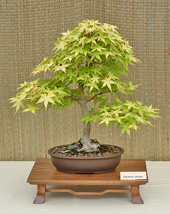Bonsai Tasks in September:
As the days grow shorter, your trees will begin to slow their growth. As temperatures drop, they begin to prepare for dormancy
Now is also time to start watching the nighttime lows in regards to any tropical bonsai that you may have outside for the summer. While some of them may not be harmed by a short duration dip in temperature, others should not be subjected to temperatures below 50 degrees. This is the time of year that I am constantly moving trees inside my greenhouse when the predictions are for temperatures below 50, and moving them back out in the morning. We still can expect some good, warm fall days. You should also begin spraying those trees that will go into the house for the winter to eliminate any unwanted critters that would love to winter over inside also.
I do not advocate any wiring or repotting in the fall, however, pruning may continue except on flowering trees as the flower buds are now being set and you would remove them, reducing the display for the spring.
Start thinking fall.
It is not too soon
to begin thinking about
winter storage. If
you have had success
with your previous
year’s methods, by
all means continue
to do the same. If
you have some misgivings,
perhaps some of the
following may be of
help.
An unheated garage
or porch is usually
preferred by most of
our members. Care should
be exercised that the
temperature does not
drop below 25 degrees
for any prolonged duration.
Buckets of water will
help to provide this
protection. Since water
can't go below 32 degrees
when frozen, the buckets
will act as heat exchangers,
warming the colder
air surrounding the
frozen buckets of water
that are in the garage.
Some members utilize a cellar window well, covered to retain heat from the basement.
An outside cellar stairway is also an excellent storage area.
Many bonsai enthusiasts bury their trees, pot and all, in their garden, in a protected spot and mulch them for the winter.
Cold frames are another good winter storage area.
Wherever you decide to keep your trees for the winter, guard against critters that would feast on them.
In preparing your trees
for the cold months
ahead, we should be
altering our fertilizing
program. If you are
feeding a high nitrogen
fertilizer, now is
the time to switch
to a 0-10-10 or some
similar low or no nitrogen
formula. It you are
feeding 7-9-5 or 7-7-7
you may continue with
the same formula until
the temperatures dictate
to stop fertilizing.
This will not only
enhance the fall colors,
but will harden your
trees and reduce winter
die back. This is a
must for your Maples,
Elms, Hackberrys, Hornbeams
and other such deciduous
trees. This is not
as critical on your
conifers, however it
is still a good idea
for them too.
Start planning now.
Don’t get caught should
the weather suddenly
take a turn for the
worse. Remember, this
is Western New York.
Enjoy what warm days we have left.

